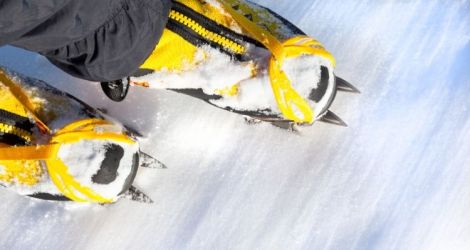Mountaineering boot grades can be tricky. This quick guide will help you better understand which boots should and can be used for certain activities, such as alpinism, mountain walking and mountaineering.

Mountaineering Boot Grades
Generally, mountaineering boots come in four grades, B0, B1, B2 and B3. Understanding when to use each type can be tricky. For example, when alpine climbing, you’re intention is to pack light. So, you want to only carry one pair of boots, unlike other climbing activities. Generally, the boots you will be climbing in should also be the ones you’re walking with. A softer boot may be easier to walk in, but not suitable for the type of climb you’re undertaking. Oppositely, a stiff boot may be perfect for your climb, but strenuous to use while walking. Other climbing activities can have you carrying more than one type of boot.
B0 Boots
B0 boots are not designed for winter climbing. They are 3-season boots and will not fare well in ice or snow. However, their softer nature will make them suitable for general mountain walking. B0 boots can be best described as flexible mountain-walking boots.
B1 Boots
Generally, B1 boots are suitable for general mountain walking in the winter. They will feature semi-stiffened mid-soles for crampons and have a more supportive upper. When it comes to their heels, they will be pretty flat. They can be defined by their robust soles, which are called “lugs”. Most likely, a B1 boot will have widely spaced notches on the sole and have rubber protection in the front and possibly on the sides. These boots are constructed with a waterproof, breathable lining.
B1 boots are often referred to as 3-4 season boots and will usually only work with C1 crampons. B1 boots are also more of a stiff mountain-walking boot.
B2 Boots
Similar to B1 boots, a pair of B2 boots will be suitable for winter mountain-walking and will fare well in ice and snow. They also work great on glacial terrain and during mid-grade climbing. Again, similar to B1 boots, their lug soles will be nearly the same, aggressive and wide-spaced. But the mid-sole will be near fully stiffened.
The B2 boot differs from the B1 boot where the upper is concerned. It will have a breathable and waterproof liner, like the B1, but these liners will be thicker, have more insulation and will be more rugged than a B1 boot. There should be rubber material around the boot, and the ankle cuff will be set higher. Generally, you will get better protection from a B2 boot. You can use either a C1 or a more technical C2 crampon with a B2 boot. B2 boots are perfect mountaineering boots.
B3 Boots
B3 Boots are technical boots and will be totally rigid. That’s because they are specifically designed for winter-climbing. Technically, you could use a B3 boot for mountain-walking in the winter but they will be very rigid and heavy. If you choose to use these boots for hiking portions of your trip, prepare for them to make the trip more tiring and strenuous. B3 boots can be used with C1, C2, and C3 crampons. B3 boots are suitable for mountaineering and winter climbing.
Here’s a great explanation on boot grading by Mountain Boot Co.
General Tips on Boot Usage
Leather boots will offer you a more precise feel while walking, and they will be cooler at lower altitudes. But plastic boots will be warmer at higher elevations and you can remove their liners and take them into your tent or bivy so they don’t freeze. Platic boots also provide more support during ice climbing and are more waterproof than a leather boot might be.
A plastic boot will not be as sensitive when walking and will be heavier. There may also be issues with its fit – over time, the liner will deteriorate and leave you with a bad fitting boot. But, plastic boots are preferred by many climbers for mountaineering because of their durability and reliability.
Insulated insoles will help you reduce heat loss in your toes and feet. But, make sure they aren’t too big. This can make a boot too tight for some feet, causing you to lose circulation to your toes over time. You want to avoid that, and use insoles that have ample wiggle room in your toes.
While we aren’t affiliated with them, we do recommend that some of the best climbing and mountaineering boots are manufactured by SCARPA, used by the late Tom Ballard during his alpine adventures and La Sportiva.
Stay tuned for more tips on crampon grades and other useful advice.
READ MORE
How to Ride Your First PNW Volcano
Recommended Mountaineering Books for Beginners
Downloadable Essential Mountaineering Gear List
